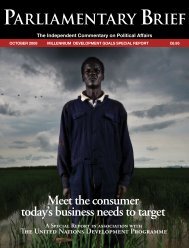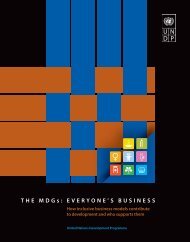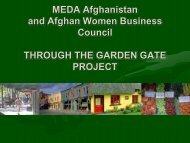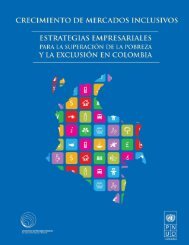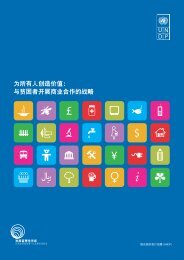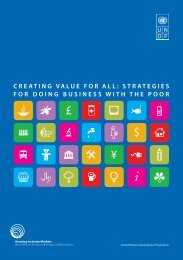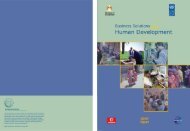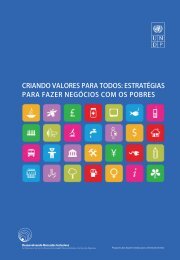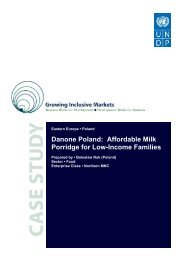Pot-in-pot Enterprise: Fridge for the Poor - Growing Inclusive Markets
Pot-in-pot Enterprise: Fridge for the Poor - Growing Inclusive Markets
Pot-in-pot Enterprise: Fridge for the Poor - Growing Inclusive Markets
You also want an ePaper? Increase the reach of your titles
YUMPU automatically turns print PDFs into web optimized ePapers that Google loves.
Market and Location ContextThe adm<strong>in</strong>istrative headquarters of Mobah Rural Horizons, producer of <strong>the</strong> <strong>pot</strong>-<strong>in</strong>-<strong>pot</strong> productswhich is widely termed as <strong>the</strong> ‘fridge <strong>for</strong> <strong>the</strong> poor’ or ‘desert refrigerators’ is based <strong>in</strong> Kano, acity that is favourably endowed with modern development dividends like electricity, <strong>pot</strong>ablewater, non-farm employment opportunities and fairly good roads. However, its ma<strong>in</strong> productioncentres are <strong>in</strong> <strong>the</strong> rural areas of Kano, Jigawa, Borno, Yobe, Sokoto, Zamfara, Kebbi and Kats<strong>in</strong>aStates, all <strong>in</strong> <strong>the</strong> nor<strong>the</strong>rn region of Nigeria. The enterprise also operates <strong>in</strong> some parts of NigerRepublic. In terms of physical, environmental, development <strong>in</strong>dices and cultural background, <strong>the</strong>region is literally homogenous.PHYSICAL AND ENVIRONMENT CHARACTERISTICS OF THE REGIONThe region orig<strong>in</strong>ally lay <strong>in</strong> <strong>the</strong> Sudan Savannah belt, a vegetative belt where luscious grassesgrew. The Sudan supports <strong>in</strong>tensive farm<strong>in</strong>g and is home to <strong>the</strong> cultivation of cereals, yam,groundnut and beans. It also provides pasture <strong>for</strong> livestock farm<strong>in</strong>g. However, decades of humanactivities have degraded <strong>the</strong> environment and caused <strong>the</strong> Sahel Savannah, <strong>the</strong> vegetation beltbetween <strong>the</strong> Sahara Desert and <strong>the</strong> Sudan, to encroach on most parts of <strong>the</strong> Sudan Savannah. Infact, desert encroachment has affected most parts of <strong>the</strong> nor<strong>the</strong>rn fr<strong>in</strong>ges of <strong>the</strong>se States. Anannual ra<strong>in</strong>fall of between 100 to 300 mm which lasts <strong>for</strong> three months (mid-June to mid-September) occurs <strong>in</strong> <strong>the</strong> region, although <strong>in</strong> <strong>the</strong> Niger Republic, ra<strong>in</strong>fall may be <strong>in</strong>frequent anddrought is a constant phenomenon. Temperatures are also high (average of 35 0 C). These areas arethus very arid. The short ra<strong>in</strong>y season supports subsistence agriculture especially <strong>the</strong> cultivationof cereals, vegetables and animal husbandry.Development Indices of <strong>the</strong> RegionNor<strong>the</strong>rn Nigeria is a very large area. While this provides <strong>the</strong> space and land to use <strong>for</strong> <strong>the</strong> goodof <strong>the</strong> people, <strong>the</strong> sheer size of <strong>the</strong> region has proved to be a major constra<strong>in</strong>t to development.Development is thus concentrated ma<strong>in</strong>ly <strong>in</strong> <strong>the</strong> capital cities of <strong>the</strong> states <strong>in</strong> <strong>the</strong> region leav<strong>in</strong>g<strong>the</strong> rural areas where most of <strong>the</strong> people reside with very little to no <strong>in</strong>frastructures. Thedeprivation of <strong>the</strong> nor<strong>the</strong>rn region stems from colonial economic development policy, whichconcentrated development ef<strong>for</strong>ts on regions that produced exportable farm products. Almost all<strong>the</strong> states <strong>in</strong> nor<strong>the</strong>rn Nigeria are categorized as <strong>the</strong> least developed of <strong>the</strong> 36 States <strong>in</strong> <strong>the</strong> countryand <strong>the</strong>re<strong>for</strong>e have <strong>the</strong> least access to <strong>the</strong> dividends of economic development. 4Most of <strong>the</strong> people live <strong>in</strong> rural areas. In Sokoto, Kebbi, Jigawa, Yobe and Bauchi States, morethan 75% of <strong>the</strong> population is rural, while <strong>in</strong> Kano, Kats<strong>in</strong>a and Borno States, up to 65% of <strong>the</strong>population is rural. These rural areas lack basic <strong>in</strong>frastructure like roads, electricity, schools and4 Abumere (1998)Case Study ● <strong>Pot</strong>-<strong>in</strong>-<strong>pot</strong> <strong>Enterprise</strong>: <strong>Fridge</strong> <strong>for</strong> <strong>the</strong> <strong>Poor</strong> 5







